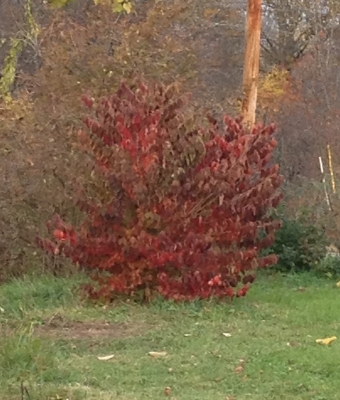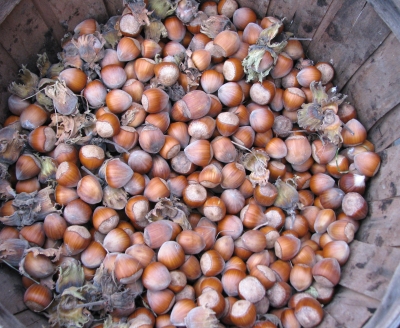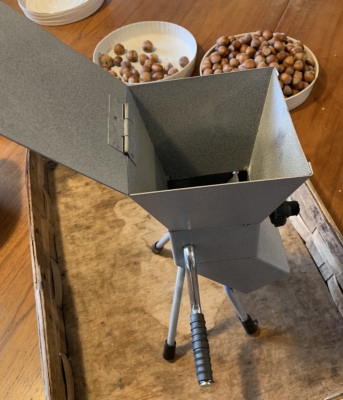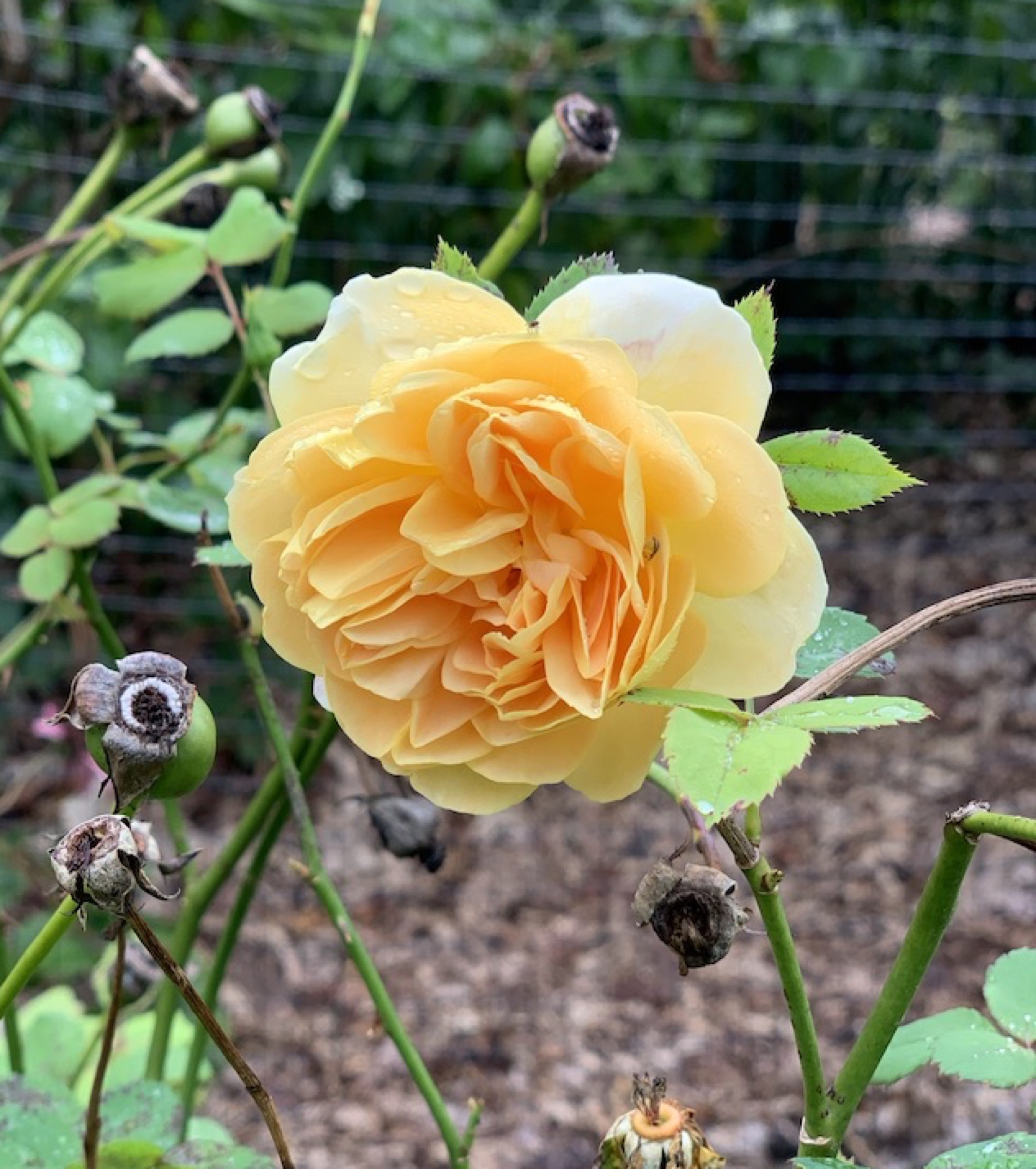FILBERT NUTS OR HAZELNUTS?
Species Matter; Varieties Matter
You say “tomayto,” I say “tomahto.” You say “filbert,” I say “hazelnut.” (“Filbert” is from St. Philibert, to whom August 22nd, is dedicated and which is the day of first ripening of hazelnuts in England.) Although hazelnuts originally referred to native American filberts, hazelnut and filbert are now equivalent.
It’s been over twenty years since I planted my first hazelnuts. Fortunately, hazels bear quickly, often within 3 or 4 years. Unfortunately, a disease called eastern filbert blight can decimate the trees, and not begin to do so for about a decade. Our native hazels (Corylus americana), having evolved with the blight, are resistant. Not so for European hazels, which are the hazelnuts of commerce.
My first planting was of our native hazel, which I planted for beauty and for nuts. It did turn out to be an attractive, suckering shrub that lit up fall with its boldly colored leaves. The nuts themselves were less notable: small and not very good tasting.
Next I planted a few old varieties of hybrid hazels, Graham, Gellatly, and Halls Giant, followed, a few years later by Tonda di Giffoni, Lewis, and Clark. All were billed as blight resistant and did quite well. In the 1960s eastern filbert blight made its way to the Pacific Northwest, the hotbed of commercial hazelnut production in the U.S. (providing 99 percent of domestic hazelnuts), which prompted breeding of resistant varieties. Lewis and Clark are two such varieties. Two more such varieties, Santiam and Yamhill, were added to my collection 11 years ago.
Right on schedule after about ten years, black pustules of blight began to show up on branches, which start to die, then finish. But the varieties I planted were blight resistant, you say. Resistance is a matter of degree (“immune” means no disease), and the varieties I planted evidently were not sufficiently resistant.

This doesn’t at all reflect poorly on breeders of these not-quite-resistant-enough hybrids. The blight fungus is capricious, changing with location and, perhaps, over time. I dug up and out all the nonproductive, diseased plants.
But I like filberts. Enter a few breeders breeding filberts right here in the northeast. One is Dr. Tom Molnar of Rutgers University, from whom I got a few selections (with nonluscious, early selection names like CR X R03P26 and CR X R11P07), which I planted back in 2014. And Jeff Zarnowski, of Z’s Nutty Ridge Nursery. And others. So now I grow Geneva (aka Gene, from Grimo Nut Nursery), Truxton, Dorris (another selection from Oregon), Raritan (a more advanced selection from Rutgers), as well as my original Rutgers plants.
I’m ready to cull again any varieties that catch blight or whose nuts are too small. For wherever plants are culled, I have potted plants of Monmouth, Hunterdon, and Somerset — all advanced Rutgers selections — waiting in the wings.
Streamlining Processing (On a Very Small Scale)
As with fruits in general, this year was also the best ever for nuts that I grow. Even the English walnuts (Juglans regia) bore a crop this year, their first substantial crop, all from 6 walnuts I planted back in 2006. I didn’t have high hopes for walnuts because they are susceptible to anthracnose disease, late frosts, and squirrels, which could conveniently harvest the nuts from the overhead squirrel highway along the road.
And the filberts — oodles of them. Mostly, we just shell and eat them. That’s fine. But for cooking with them or concocting a delicacy such as, say, fig-hazelnut jam, shelling nuts one at a time is too slow.
A quick web search turned up a couple of very elegant, home made shellers that work reasonably well. Luckily, before I delved too deeply in how I was going to fabricate one of these out of metal, I did a web search and found one available for about $30.
(These kitchen counter hazelnut sheller are manufactured in Turkey, which grows 70 percent of the world’s hazelnuts. Want another fun fact? Twenty-five percent of the world’s production goes into making Nutella and Ferrero Rocher, both hazelnut and chocolate confections made by the Luxemburger company Ferraro.)
One problem with the sheller is that it needs adjustment for nut size, so it is recommended to do some sorting into size ranges before running nuts through the sheller. This I could make myself, easily. Basically, it is an open wooden box whose bottom has 3/8 inch square, wooden dowels spaced 5/8 inch apart, which is pretty much the size of my largest hazelnuts in the shell. The corners of the box are joined by hinges so that the sides can be moved to deform the shape. As the box deforms increasingly to a parallelogram, the distance between the dowels decreases. A pegged slat from one side of the box to n adjacent side holds the box to the desired shape and dowel spacing.
So I just adjust the box to the smallest dowel spacing needed, about 3/8 inch apart, dump on a bunch of nuts, and shake. Then I move the spacing up to about 1/2 inch, then shake again. And finally, move spacing to 5/8 inch, and . . . well, you know.

I could be on my way to hazelnut butter, chopped hazelnuts sprinkled on everything, that fig-hazelnut jam, perhaps even home made Nutella. No rush. Once sufficiently dried (to 6 percent moisture, which takes a couple of weeks), hazelnuts store well in their shells for over year. Shelled and refrigerated, they keep for for about six months




I seem to recall efforts to grow black truffles on the roots of native varieties. Are you aware of any success with that?
I don’t know that detail but I do know that there have been a lot of efforts, and successes, with growing truffles on hazel. At least one nursery in the Southeast sells pre-innoculated plants.
I’m curious if you’ve ever grown the ornamental Corylus avellana ’Contorta’, and if it is susceptible to the same blight issues
I haven’t grown it but I’ve seen it a lot. I’ve never seen blight on it — or nuts. The lck of nuts is probably due to lack of a nearby pollinator.
I had planted some native hazelnuts from FEdco several years ago. They are spreading nicely, and although fruit for me would be nice, I really planted them for the native grouse population who also like the catkins. Along with my crabapple, the grouse are frequently in my yard, along with a dozen or so wild turkeys on occasion.
Nice!!
I have two hazelnut bushes planted 3 or 4 years ago. This year, for the first time they were full of the clusters of nuts. I checked them again in Sept. There was not one nut on the bush. We have deer, woodchucks and squirrels. Would they eat off the nuts and would netting protect the bushes? The leaves were not chewed.
Marlene
Probably squirrels and, if they’re around, chipmunks. Deer and woodchucks might also eat them. Netting would not be effective. I use a multi-pronged — no, not a pitchfork 🙂 — approach to keeping animals. I have two dogs that live outdoors. I do some trapping. You could also train the plants as small trees, with single trunks around which you have a couple of feet of metal chimney pipe or an upside down cone. If the lowest branches ar ehigher than 6 feet, squirrels should not be able to jump into the branches of climb the trunks.
Thanks for your response. WE have lots of squirrels and chipmunks here in the Adirondacks. Maybe I will try Plantskydd next year. Maybe I will try to develop one of the shrubs into a standard. I was successful with a Hakura willow.
Marlene
I ordered Hazelberts for planting this spring. They’re supposed to be a cross of Skinner (Hazelnut) X Graham and Winkler. Have you had any experience or encounters with such plant as to blight resistance, nut quality and tree size?
I’ve grown Graham Hybrid. It is susceptible to blight but still bears every year. The nuts are quite large and flavorful. It suckers just like American filberts.
My husband and I are thinking of planting 6 hazelnuts in Maryland, zone 6B. Given your current experience, what breeds would you recommend for the best combo of blight resistance and tasty nuts? Thanks
I’d probably recommend the new varieties from the Rutgers breeding program, although they are a little hard to get. They include ‘Raritan’, ‘Monmouth’, ‘Hunterdon’, ‘Somerset’, and some others. Check out Foggybottomhazelnuts.com.
Thank you so much! I’ve been trying to do a lot of research on the web and coming across an article from you has been the most helpful. Also, we grow figs (Chicago Hardy and Celeste) and I’m going to get your book on growing cold weather figs.
I have had American and European hazelnut “trees” for 30 years that produce thousands of nuts every year. As soon as they are ready to harvest. squirrels descend upon the entire mass and denude the shrub-like trees. in a matter of hours. Can I somehow pick them early to beat the wild little twerps or what? There are sprouting hazelnuts all over my yard and farther
I use a multipronged approach: trapping, 2 outdoor dogs and 1 outdoor cat, and maintaining an unmowed meadow up to a few feet away from the plants. I believe that squirrels won’t go into high grass; perhaps it slows them down too much.